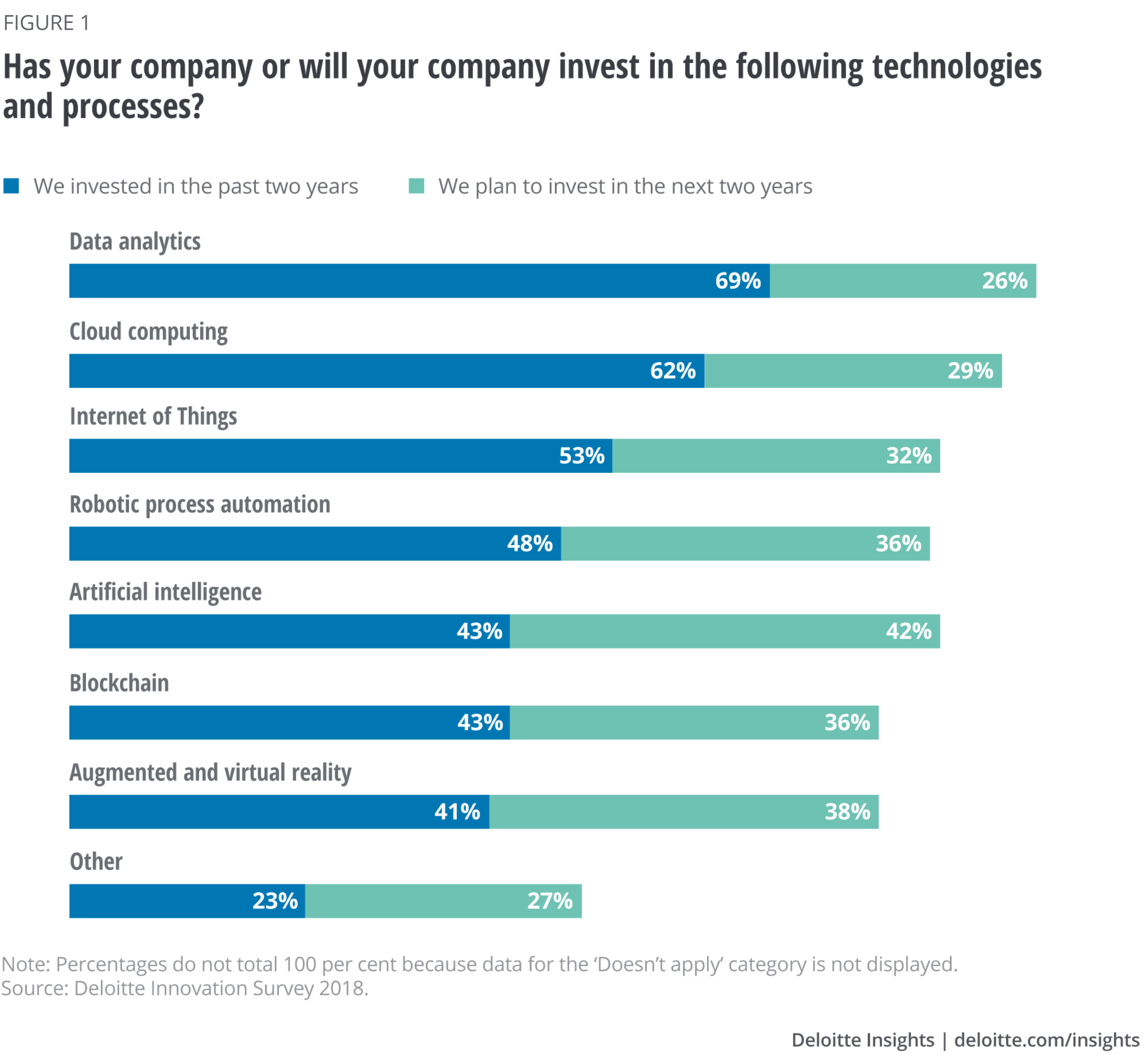
Innovation in Europe A Deloitte survey on European companies and how digital technologies can strategically enhance innovation
4 minute read
29 January 2019
In the competition for the digital future, Europe is often seen as suffering an ‘innovation deficit’. However, the region is investing significantly in technology, people and systems to remain an innovation powerhouse.
With innovation now intimately linked to the notion of the digital future, Europe is often seen as having been outflanked technologically by both Asia and the United States and at risk of being left behind because of a long-term lack of investment in research, digitalisation and education.
But this view is, in Deloitte’s judgement, excessively bleak. Growth is recovering in Europe and there is an optimistic, vibrant air in the region that is fostering a renewed sense of ambition.
Learn More
The Innovation in Europe report is also available in Spanish
View the Innovation collection
Subscribe to receive related content
In a hurry? Read a brief version from Deloitte Review, issue 25
Create a custom PDF or download Deloitte Review, issue 25
Download the Deloitte Insights and Dow Jones app
This Deloitte report investigates how companies in Europe are developing digital, data-driven technologies to augment human physical and mental abilities. Specifically, the report examines the triggers of innovation and its implementation in relation to three critical enabling factors:
- Technology. The digital technologies European firms are choosing to invest in, their motivations for doing so and how these technologies are being implemented.
- The human factor. The implications these digital technologies have for the future workforce, and how companies are using digital transformation to develop innovation cultures.
- Innovative organisation. How processes are being designed to create organisations that foster and spur innovation, and what is hindering innovation in companies.
Innovation is a strategic priority
The survey examined which technologies are being implemented and where. Investments in data analytics (69 per cent) and cloud computing (62 per cent) are already well advanced, with another 26 per cent of firms expecting to invest in data analytics in the next two years and 29 per cent in cloud computing (figure 1).
Companies are prepared to further invest in the potential of new technologies. Some 88 per cent expect their innovation budget to increase over the next two years. The other 12 per cent expect it to remain the same. The question is, where will this budget be spent? Artificial intelligence (43 per cent), augmented and virtual reality (38 per cent) and robotic process automation (36 per cent) will also be areas of focus over the next two years.

Pursuing innovation strategies
The best way to drive innovation is to apply a disciplined, consistent method across the entire value chain. One widely used framework identifies ten powerful types of innovation. These types do not necessarily deal specifically with digital technologies; rather, each type is enhanced by the application of such technologies.
In the survey, interviewees were asked about the types of innovation they pursue based upon this framework. From the survey, it emerges that one in three European companies uses the ten types of innovation, and only ten per cent use four types or less. Combining four or more types of innovation opens companies to new possibilities and strengthens innovation. Four or less implies there are gaps in the strategy and the company may be missing innovative opportunities.
When analysed on a sector level, technology is clearly leading, in that technology companies typically apply innovation in all ten areas. This is followed by the industrial products and services industry. Most European companies are currently innovating around the profit model, changing the way money is earned. This is followed by workflow process changes, the structuring of talent and organisation of assets.
There is evident weakness in the approach of European companies to customer engagement. One in every four companies does not focus on improving customer engagement, while one in three neglects channel and brand innovation. In Europe, it appears that the way products and services are presented to customers and how the brand is represented through offerings and the business is not a primary concern for many companies.
Advanced technologies are not expected to destroy jobs
‘Robots are coming for our jobs’ is a common theme in headlines, with up to 2 billion jobs predicted to disappear by 2030 in some estimations. But a debate is now raging between those who argue we face an era of unprecedented technology-provoked unemployment, and those who claim job prospects for people with the right mix of talent have never been better.
In Europe, our survey suggests workers have little to fear. Companies strongly believe their staff headcount will actually stay the same or increase as a consequence of new technologies. Most expect full-time headcount to increase (41 per cent) or remain the same (29 per cent). Only 23 per cent expect a decrease – although there are markedly divided opinions in some industries, such as banking and finance. Instead, one in two companies (49 per cent) expects to invest in substantial training in new technologies to upskill their workforce, as well as in leadership development (45 per cent).
Innovation is far from dead in Europe
Europe still reveals a strong ability as an innovation powerhouse. Traditional levers of innovation provide an indication of the vitality of innovation and reveal that Europe has certainly not been left behind in the race to the digital future. However, this Deloitte survey indicates five significant areas where European companies can improve:
- Avoid the trap of focusing on technology alone. With nine out of every ten European companies poised to increase innovation budgets, there is a danger that firms could focus solely on implementing technology. Companies need to remain aware that successful innovation requires the right technology, as well as the right people and the right organisation structures.
- Understand the multidimensional nature of innovation. There is a danger when companies think of innovation in narrow terms. This survey indicates there are significant innovation improvement opportunities available to European companies not already using all ten types of innovation and, in particular, for the ten per cent using only four types of innovation or less.
- Prioritise skills. To exploit the innovative opportunities that digital technology offers, the workforce needs to be upskilled. European companies are prepared to invest in this and recruit talent when necessary, yet could do far more in making themselves know to potential employees. In particular, by engaging with universities, they could place themselves in a better position to recruit students from the critical science, technology, engineering and mathematics (STEM) subjects.
- Cultural change is the underlying essential for innovation. To overcome cultural resistance to change, companies must strive to involve the workforce. Employees must come to understand how innovating business processes can keep firms competitive. An innovative mindset and innovative incentives need to become part of the organisation setup.
- Use the power of ecosystem innovation. European companies seem reluctant to engage with external resources. The potential of collaboration with external partners to share knowledge, stay abreast of developments, expand market reach and provide complementary expertise needs to be fully utilised if innovation is to be fostered in Europe.
To learn more, access the full report: Innovation in Europe: A Deloitte survey on European companies and how digital technologies can strategically enhance innovation.
Trending articles
-
Coming of age digitally Article6 years ago
-
The future of regulation Article6 years ago










